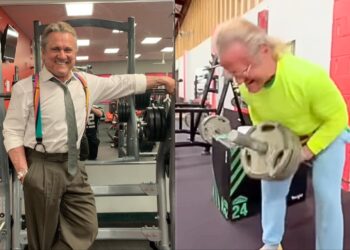Bulging discs are one of the most common conditions that will derail your workouts quickly.
In the following video, Jeff from the YouTube channel Athlean-X shows you how to fix a bulging disc in your lower back without requiring surgery. In just 3 simple steps you are going to be able to get rid of the pain that is wreaking havoc on your training and making your life miserable.
The first thing that needs to be discussed however are the terms used to describe the condition. Some people refer to a bulging disc as a herniated disc. In both cases, we are talking about a scenario where the inner disc material has protruded from the disc but has not reached a point of no return. The point at which the disc can no longer be repaired without surgery is more accurately called a ruptured disc.
Bulging discs are a very common problem and one that we all might have to some degree if we were to MRI our backs. The thing is, however, just because we may have a disc that is bulging does not mean that we will have symptoms. The only time it starts to matter is when the presence of the disc starts to become symptomatic and interferes with your life or workouts.
Watch the video:
The good news about disc issues, however, is that 98 percent of them are non-operative and solved with a dedication to just a few simple steps. One of those steps, however, is not stretching the lower back. This may come as a surprise to you, especially if you feel that your low back has become tight or sore as a result of your disc issues.
Far too many people are told to lay on their back and start pulling their knee or knees up to their chest to stretch out the tight muscles in the low back. They may even be told to get on their knees and sit back on their heels to stretch out all of the muscles of the back. Both of these would be horrible advice because they not only aren’t treating the cause of the problem but they are aggravating the actual cause and making the disc protrude even more.
Level Up Your Fitness: Join our 💪 strong community in Fitness Volt Newsletter. Get daily inspiration, expert-backed workouts, nutrition tips, the latest in strength sports, and the support you need to reach your goals. Subscribe for free!
What you need to do is focus on fixing the disc and recentralizing it through extension. If you can do this, the spasm that you are experiencing in the low back muscles as a result of the herniation will resolve once the disc itself is fixed. There are 3 parts to fixing this issue however and it starts with a decompression of the spine to allow for more room for the nerves that are being compressed by the disc protrusion.
This can easily be done by hanging from a pullup bar with your toes slightly in contact with the ground. Let the pelvis drop and feel the spine open up. Do this for about 30 seconds to a minute and then proceed to step two if you need it or just skip to step three if not. Step two is a list correction. This is needed if you find that you are leaning to one side because of the pain of the protrusion.
This can easily be done against a wall and will help to put the spine back in the proper alignment prior to moving on to the final step. Lay on your stomach with your hands under your shoulders. Press down on the floor and lift your upper torso off of it. Be sure to keep your hips in contact with the ground to avoid overextension of the lumber spine. Do this a few times a day and always within a zone of comfort.
Before you know it, your disc will be centralized and your pain and symptoms down the leg and in the lower back should subside. You will be ready to start attacking your workouts again in no time.








